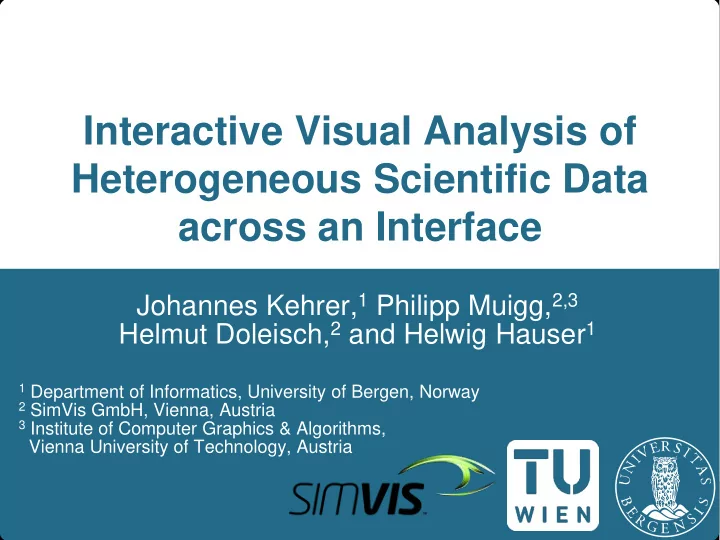

Interactive Visual Analysis of Heterogeneous Scientific Data across an Interface Johannes Kehrer, 1 Philipp Muigg, 2,3 Helmut Doleisch, 2 and Helwig Hauser 1 1 Department of Informatics, University of Bergen, Norway 2 SimVis GmbH, Vienna, Austria 3 Institute of Computer Graphics & Algorithms, Vienna University of Technology, Austria
Heterogeneous Scientific Data Single-part scenarios given in a coherent form (spatio-temporal / multi-variate) Multi-part scenarios time-dependent 3D data 2 or more related data parts different simulation models different data sources various data grids different dimensionality (2D/3D data) coupled climate model Johannes Kehrer 1
Multi-physics Simulations Example: fluid-structure interactions (FSIs) movable or deformable structure fluid flexible roofs, bridges, blood flow in arteries, etc. [Bungartz & Schäfer 2006] cooler aluminum foam heat exchange Johannes Kehrer 2
Sample Analysis of Heat Transfer How is the heating (solid) influenced by surrounding vortical flow? feature transfer vortex feature Johannes Kehrer 3
Multi-part Scenarios (cont.) Coupled climate models Land [ Böttinger, ClimaVis08 ] Johannes Kehrer 4
Multi-part Scenarios (cont.) 3D time-dependent Data in scientific visualization multi-run simulation data data values f ( x ) data distribution per cell (e.g., temperature, pressure values) measured/simulated wrt. a domain x (e.g., 2D/3D space, time, simulation input parameters) Dimensionality reduction (e.g., computing statistics wrt. time / spatial axes) Reintegrate statistics into IVA through attribute derivation Johannes Kehrer 5
Visual Analysis across an Interface Multiple linked views framework [Doleisch et al. ’03] Integrate 2 related data parts Common level of data abstraction degree-of-interest attribution ( DOI i [0, 1]) data part 1 data part 2 feature transfer Johannes Kehrer 6
Interface Relate grid cells across data parts (no resampling necessary) data part 1 data part 2 DOI transfer feature transfer Automatic update of feature spec. data part 1 data part 2 Analysis strategies for 2-part scenarios feature refinement Johannes Kehrer 7
Interface (structural relation) relate grid cells weight values for DOI transfer many-to-many relation aggregated multi-run data one-to-many relation Johannes Kehrer 8
Degree-of-Interest (DOI) Transfer weighted sum maximum weighted DOI values maximum DOI value other model-based transfer Johannes Kehrer 9
Case Study: Multi-run climate Data Cooling event (8200 yrs ago) year 100 ocean simulation (2D sections) 10 x 10 = 100 runs time-dependent (250 time steps) Compute statistics wrt. the multiple runs median, quartiles, etc. billboard glyphs [Lie et al. 2009] size: IQR Johannes Kehrer
Case Study: Multi-run climate Data Cooling event (8200 yrs ago) year 100 ocean simulation (2D sections) q 3 10 x 10 = 100 runs q 2 time-dependent q 1 (250 time steps) Compute statistics wrt. the multiple runs median, quartiles, etc. billboard glyphs [Lie et al. 2009] size: IQR Johannes Kehrer
Visual Analysis of Multi-run Data aggreg. multi-run data aggregated data Starts at aggregated level (summary statistics) specify features via brushing derive new attributes multi-run data Refine features at multi-run level (details) Investigate further Johannes Kehrer 12
Visual Analysis of Multi-run Data aggreg. multi-run data aggregated data Starts at aggregated level (summary statistics) specify features via brushing derive new attributes multi-run data Refine features at multi-run level (details) Investigate further Johannes Kehrer 13
Outlier Analysis: Aggregated Data multi-run data year 60 Derive total number of outlier Where are outlier located? (% outlier > 3 rd quartile + 1.5 IQR) – (% outlier < 1 st quartile – 1.5 IQR) aggregated data aggregated data
Feature Refinement: Multi-run Data aggr. multi-run data Derive measure of outlyingness [Kehrer et al. 2010] Johannes Kehrer 15
Feature Refinement: Multi-run Data aggr. multi-run data Derive measure of outlyingness [Kehrer et al. 2010] Johannes Kehrer 16
Sensitivity Analysis aggregated data multi-run data multi-run data 17
Conclusions Joint visual analysis across two data parts Bidirectional feature transfer via interface Workflow for analyzing 2 data parts simultaneously multi-run data aggregated statistics fluid structure Aggregated statistics and measures of outlyingness Johannes Kehrer 18
Acknowledgements Thomas Nocke, Michael Flechsig Peter Filzmoser Andreas Lie, Stian Eikeland, Cagatay Turkay, Armin Pobitzer Matthew Parker, Brendan McNulty, David Horn FSI data courtesy of Innovative Computational Engineering GmbH VisGroup Bergen many others Johannes Kehrer 19
Recommend
More recommend